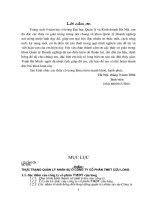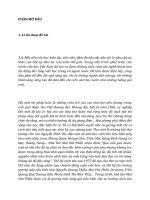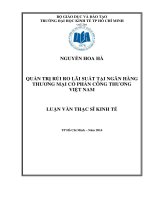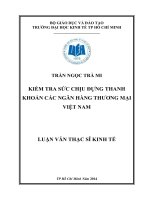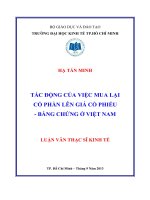(Luận văn thạc sĩ) e commerce logistics in vietnamthe reality and solutions logistic trong thương mại điện tử ở việt namthực trạng và giải pháp
Bạn đang xem bản rút gọn của tài liệu. Xem và tải ngay bản đầy đủ của tài liệu tại đây (1.75 MB, 87 trang )
ĐẠI HỌC QUỐC GIA HÀ NỘI
KHOA QUẢN TRỊ VÀ KINH DOANH
---------------------
NGUYỄN VĂN THỊNH
E-COMMERCE LOGISTICS IN VIETNAM
THE REALITY AND SOLUTIONS
LOGISTIC TRONG THƯƠNG MẠI ĐIỆN TỬ
Ở VIỆT NAM: THỰC TRẠNG VÀ GIẢI PHÁP
LUẬN VĂN THẠC SĨ QUẢN TRỊ KINH DOANH
HÀ NỘI - 2018
ĐẠI HỌC QUỐC GIA HÀ NỘI
KHOA QUẢN TRỊ VÀ KINH DOANH
---------------------
NGUYỄN VĂN THỊNH
E-COMMERCE LOGISTICS IN VIETNAM
THE REALITY AND SOLUTIONS
LOGISTIC TRONG THƯƠNG MẠI ĐIỆN TỬ
Ở VIỆT NAM: THỰC TRẠNG VÀ GIẢI PHÁP
Chuyên ngành: Quản trị kinh doanh
Mã số: 60 34 01 02
LUẬN VĂN THẠC SĨ QUẢN TRỊ KINH DOANH
NGƯỜI HƯỚNG DẪN KHOA HỌC: TS. BÙI QUANG HƯNG
Hà Nội - 2018
DECLARATION
The author confirms that the research outcome in of this thesis is the result
of author‟s independent work during study and research period, and it is not yet
published in other‟s research and article.
The other‟s research results and documentation (such as extractions, tables,
figures, formulas and other document) used in the thesis are cited properly, and the
permission (if required) is given.
Plagiarism in this Thesis will not be tolerated by The author is responsible
in front of theLaws and Thesis Assessment Committee, Hanoi School of Business
and Management, and the laws for above-mentioned declaration.
Date: December 11, 2017
ACKNOWLEDGEMENT
I have gained huge knowledge, skills and insights from my MBA course. The
course raises my capacity of administration and management up to the next level. I
am now very confident in my position of management. I would like to extend my
sincerest thanks and appreciation to all those who have helped me makde this
Thesis to be possible.
First of all, I would like to express my deepest and sincerest gratitude to my
supervisor, Dr. Bui Quang Hung for his useful comments, remarks and engagement
during my process of doing this master Master Tthesis.
I would like to give my sincere thanks tocustomers who have purchased and
used the services of logistics businesses, in my survey, who have willingly spent
their precious time joining the interviews.
Sincere thanks are extended to the Hanoi School of Business and
Management (HSB) - Vietnam National University for equipping me with huge
knowledge and skills through various interesting and practical subjects. I also
would like to thanks my classmates for their friendship and reciprocal
encouragement to make our class time to become unforgettable time.
Lastly, I would like to give my great thanks to my family who have been
always standingby me during for the past two years, and encourages encouraging
me to keep moving from the beginning of my study.
Formatted: Space After: 0 pt
This page is intendedly left plank
E-COMMERCE LOGISTICS IN
VIETNAM
THE REALITY AND SOLUTIONS
E-Commerce logistics in Vietnam
The reality and solutions
1. Summary of the results
The result of the thesis is to provide the solutions of logistics for e-commerce
in Vietnam. Study on the general situation of logistics and logistics in e-commerce
in Vietnam. Propose Proposing solutions (infrastructure of transport, technology
and policies) related to logistics is to support E-commerce development.
2. Applicability in practice
E-commerce is a growing field in the world, as the trend is irreversible.
However, in Vietnam there are many obstacles to the development of e-commerce
and the biggest barrier now is the logistics (logistics for e-commerce). The thesis
studiesy on the ongoing issues at the big e-commerce companies in Vietnam and
around the world, opportunities and challenges in the coming time to provide
practical solutions to overcome these exist to be able to support Vietnam ecommerce development.
Comment [THP1]: Khơng có vị ngữ. (nghiên cứu
các tình tình trạng chung của Logistics và Ecommerce Logistics...để làm gì?
TABLE OF CONTENTS
LIST OF TABLES .............................................................................................................. i
LIST OF FIGURE ............................................................................................................. ii
FOREWORD ...................................................................................................................... 1
1. Problem of statement .......................................................................................... 1
2. Literature review ................................................................................................. 2
3. Research objectives............................................................................................. 4
3.1 General objective ....................................................................................... 4
3.2
Detail objectives ..................................................................................... 4
4. Research subjects ................................................................................................ 5
5. Research scope .................................................................................................... 5
6. Research methodology........................................................................................ 5
6.1 Data collection methods ................................................................................... 5
6.2 Data processing methods .................................................................................. 6
7. Research structure ............................................................................................... 6
CHAPTER 1: THEORETICAL FRAMEWORK ON E-COMMERCE AND
LOGISTICS IN E-COMMERCE ................................................................................... 7
1.1 E-commerce ...................................................................................................... 7
1.1.1 Concept.................................................................................................... 7
1.1.2 Components of e-Commerce ................................................................... 8
1.1.3 Ecommerce models ................................................................................ 11
1.1.4. The role and benefits of e-Commerce .................................................. 12
1.2 Logistics in e-commerce ................................................................................. 16
1.2.1 General concept .................................................................................... 16
1.2.2 Components of Logistics in e-commerce............................................... 16
1.3 Factors influencing logistics in e-commerce .................................................. 19
1.3.1 Macro Factor ........................................................................................ 19
1.3.2 Subjective factors .................................................................................. 20
CHAPTER 2: LOGISTICS STATUS IN E-COMMERCE OF THE WORLD
AND VIETNAM ............................................................................................................... 23
2.1 Logistics Status in E-Commerce of the World ............................................... 23
2.1.1 Research at Amazon. ............................................................................. 23
2.1.2 Research in Wal-Mart ........................................................................... 29
2.1.3 Overall evaluation of logistics solutions in e-commerce in the world .. 34
2.2 The status of logistic in Viet Nam .................................................................. 35
2.2.1 Research at Sendo.vn ............................................................................ 35
2.2.2 Research at Tiki.vn ................................................................................ 43
2.2.3 Analyzing the influence of factors on logistic behavior in e-commerce49
2.2.4 Customer survey .................................................................................... 55
2.2.5 Summary of SWOT Matrix .................................................................... 61
CHAPTER 3: SOLUTIONS TO COMPLETE LOGISTICS IN E-COMMERCE
IN VIETNAM ................................................................................................................... 64
3.1 Logistics operations development direction in Vietnam e-commerce sector . 64
3.2 The proposed solutions for Logistics activities in the EC in Vietnam ........... 65
3.2.1 proposed solutions to business .............................................................. 66
3.2.2 Recommendations to the State .............................................................. 69
REFERENCES ................................................................................................................. 72
APPENDIX........................................................................................................................ 74
Survey Questions .................................................................................................. 74
LIST OF ACRONYMS
1
APEC
Asia-Pacific Economic Cooperation
2
B2B
Business-to-business
3
B2C
Business-to-consumer
4
B2G
Business-to-Government
5
C2C
Consumer-to-consumer
6
C2G
Customer to Government
7
CPFR
Collaborative Planning, Forecasting and Replenishment
8
EDI
Electronic data interchange
9
POS
Point of Sale
10
SMS
Short Message Services
11
VND
Viet Nam Dong
LIST OF TABLES
Table 1.1: E-commerce models ........................................................................................... 11
Table 2.1: Amazon's refund policy ...................................................................................... 29
Table 2.2: Service prices in the city on Shipchung.vn ......................................................... 38
Table 2.3: Prices in interprovincial ...................................................................................... 40
Table 2.4: Return Policy of Sendo.vn .................................................................................. 41
Table 2.5: Refund processing at Sendo.vn........................................................................... 42
Table 2.6: Order processing capacity................................................................................... 45
Table 2.7: Delivery fee and order processing at Tiki.vn...................................................... 46
Table 2.8: Return goods policies of Tiki.vn ........................................................................ 47
Table 2.9 : Customer survey results ..................................................................................... 55
Table 2.10: Customer survey results .................................................................................... 57
Table 2.11: Customer survey results on transportation activities ........................................ 59
Table 2.12 : Customer survey results on Return shipping ................................................... 60
i
LIST OF FIGURE
Figure 1.1: Components of e-Commerce ....................................................................................9
Figure 2.1: Process Order at Amazon .......................................................................................23
Figure 2.2: The application process at Amazon........................................................................ 25
Figure 2.3: Amazon Warehouse ...............................................................................................26
Figure 2.4: Amazon's warehouse system .................................................................................. 27
Figure 2.5: Amazon's shipping process ....................................................................................28
Figure 2.6: Process Order at Wal-Mart .....................................................................................30
Figure 2.7: Walmart's warehouse systems ................................................................................ 31
Figure 2.8: the inventory management process at Wal-Mart ....................................................31
Figure 2.9: Cross-docking technology process at Wal-Mart ....................................................33
Figure 2.10: Processing online at Sendo.vn .............................................................................. 36
Figure 2.11: The number of orders per day on sendo.vn ..........................................................37
Figure 2.12: Processing online at Sendo.vn .............................................................................. 43
Figure 2.13: Number of orders.................................................................................................. 44
Figure 2.14: Infrastructure information technology.................................................................. 51
Figure 2.15: the level of use of electronic equipment in enterprises in our country .........................52
Figure 2.16: About using email by enterprise size..................................................................... 53
Figure 2.17: Charted the cost of procurement and application of information technology in ecommerce .................................................................................................................................. 54
ii
FOREWORD
1. Problem of statement
Globalization and international integration brings tremendous opportunity
opportunities for enterprises after Vietnam joins series of international trade
organizations (WTO-2007, TTP 2015, EVFTA-2015, ASEAN-AEC...). However,
most business executives and enterprises managers spend a lot of time for finding
solutions to overcome challenges and competitive pressures than expected business
opportunities that these agreements bringing out.
The solutions are often mentioned in economic research and business strategy
building such as: enhancing product quality, reduce product costs, building and brand
management, innovation-creative, enhance qualifications, modernizing equipment and
technology, increasinge investment and international cooperation ... These solutions
are absolutely correct in terms of business strategy. However, to help make these
strategies are effective as expected, the internal problems of the business needs to be a
basically rebuilding, which , logistics is one of the aspects that businesses in Vietnam
have not yet widely appreciated. This is an activity that appeared in the entire process
of production and business of enterprises. Logistics take an important role in the
planning and using of materials in production, transferring of goods to consumers, and
even in the management process of funds and human resources. This activity
contributes to lowering the cost of production and business, shortening the time for
circulation of goods, capital optimization, ensure deadline and progress of business
contracts and partly enhance reputation and corporate brand.
In electronic commerce (E-commerce), logistics plays an active role in the
Back-End1 activities of E-commerce enterprise with the basic objective is the delivery
time, a sufficient number quantity, right place, right customers ... enhances
competitive advantage for businesses. Although since 2011 to date, the logistics
service in Vietnam has been developinged rapidly, it has not yet to meet the needs of
e-commerce. Also, many e-commerce businesses (considered as the big enterprises in
the field of e-commerce) must be close downd last year as: Beyeu.vn, Deca.vn,
Fab.vn, and Lingo, recently.
1
In the field of e-commercial, we use the term of "Back-end" to talk about the process since online customer accept buying to the
time of goods, products be delivered to customer.
1
Comment [THP2]: Không hiểu ý câu này là gì
nên khơng chỉnh được ngữ pháp. Hiện ngữ pháp và
cách dùng từ đang bị sai.
Vietnam E-commerce and Information technology Agency (VECITA) reported
that, the interests of online consumers in Vietnam have not been adequately protected.
While 40% of online customers think that the price of online shopping is not cheaper
than tradition, 38% are worriedy (and complain) about the time of delivery (sometime
missing or lost). In addition, as the report of VECITA, Vietnam E-commerce is not as
developed as its potential2. This is the biggest barrier to e-commerce businesses in
Vietnam, and this is one of the top priorities that businesses in the field of e-commerce
in Vietnam have to solve remove/ take off in the near future.
With these above briefly outlined of limitations, the author selected the topic
"E-Commerce logistics in Vietnam: The reality and solutions" to complete the
Mmaster Tthesis.
2. Literature review
Logistics in business is not a fledgling area of research in the world (as in
Vietnam). The first study in this area was formed in the lately 60s of the last century
by E.W. Smykay, Donald J. Bowersox, Frank H. MossmanEW Smykay, Donald J.
Formatted: Font: 13 pt, Italic
Bowersox and Frank H. Mossman3 with a book about "Physical distribution
development, current status, and potential"”. In this study, the authors acknowledged
the formation of a new business field called Logistics (associated with company of
Malcolm P. McLean - the father of the oversea shipping industry - the beginning of the
global logistics sector). The authors noted that this is a totally different activity is way
more different thanfrom the stages and processes of distributation in marketing and
purchase management in production. Shortly after this publication was published in
1969, the researchers and the business world were quick to learn the terminology of
this logistics, contributing to the rapid development of a new study field in business.
Research by Heskett, J.L., Glaskowsky, N.A. and Ivie Jr4 titled "Business
Logistics", was published in 1973. In this period, the study of logistics issues to
focused on distribution operations to reduce business costs. Research has proven
Logistics accounts a large amount of resources and the cost of production and business
2
3
With more than 90 million of population, 44%-48% population use internet, just 2.6 million online customers.
Bowersox, D. J. (1969). Physical distribution development, current status, and potential. The Journal of
Marketing, 63-70.
4
Heskett, J. L., Glaskowsky, N. A., & Ivie, R. M. (1973). Business logistics; physical distribution and materials
management (Vol. 1). Ronald Press Co..
2
Formatted: Font: 13 pt, Bold, Italic
operations, and at that period, problem of optimization of logistics is being left (it did
not take much care of enterprise at that time). Therefore, solving the problems of
logistics can provide huge competitive advantage for businesses. The findings
resonated large and manufacturing enterprises soon gathered optimum distribution
process, transport…that opening the period of distribution of matter in the Logistics.
However, electronic trading was underdeveloped, so this study purely confined
Logistics within the visible material.
In 1985, Jack W.Farrell made a research breakthrough in the field of logistics.
Farrell‟s study titled of "New Clout for logistics". ”. This study demonstrated the
Formatted: Font: 13 pt, Bold, Italic
effectiveness of logistics wouldill increase when we consider Logistics on the
integration view. At the same time, the study also confirmed integrated Logistics will
would bring more profit and competitive advantage for enterprises, improving the
image and relationship with customers. However, despite the views of FARELL is
correct, this study has not implemented quantitative benefits that the authors stated.
On the e-commerce field, the concept of logistics was originally considered as
the traditional view (transport, cargo transfer ...). However, theseis views were quickly
rejected and backward with the rapid changes of e-commerce. However, until now,
research on the logistics of e-commerce is still a new array of topics in the world.
In 2000, Deborah L.B5 made a first study on the logistics of e-commerce, called
"“E-Commerce Logistics & Fulfillment: Delivering the Goods".”. This work is
fundamental reference for many next-after researches on theoretical perspectives and
model. However, the major limitation of this study is that the scope of study conducted
in the UK, where e-commerce is not large enough (in the world) to widely applied.
Recently, in 2013, Zhang Jin Shan conducted research "“Logistics and e-
Formatted: Indent: First line: 1.27 cm, Space
After: 0 pt
commerce logistics management". ”. This is an in-depth study on logistics in Ecommerce. Beside the comprehensive overview of E-commerce logistics, this study
has performed a quantitative analysis of E-commerce cooperation in China - the
largest online market of the world. However, the author is not proposingdid not
propose radical solutions to support the growth of Ecommerce in China Logistics
Formatted: Font: 9 pt, French (Canada)
5
Bayles, D. L., & Bhatia, H. (2000). E-commerce logistics & fulfillment: delivering the goods. Prentice Hall PTRPrentice Hall PTR.
3
Formatted: Font: 9 pt, Italic, French (Canada)
Formatted: Font: 9 pt, French (Canada)
In Vietnam, the researches on this field were most deployed on the base of
traditional view of logistics. On the aspect of the international experiences, study made
by the Ministry of Trade of Vietnam (2006) (ministerial-level) with the title of
“International experiences in Logistics and lessons for Vietnam"is was a good
reference. In this study, the authors assessed the impact of logistics to business and
business results of enterprises in Vietnam, in general. The success of this study on the
lessons of international experience that is was very useful for Vietnam. However, the
authors have did not mentioned field of E-commerce logistics.
Another theoretical study is the lecture book of Van, Doan Thi Hong. This is a
pretty comprehensive product. This book contents 11 chapters all about the Logistics
activities that includes: overview of the logistics, the logistics services sector,
Logistics solution, Logistics Administrator, Customer service, Information systems,
Reserves, Managing supplies, determine the need of supplies and materials demand
forecast, transportation, warehouses. However, as the same with the study of Ministry
of Trade of Vietnam (2006), this study does not include reference to the category of ecommerce logistics.
Thus, after the process of the review study, the authors recognize the “research
gaps” in Vietnam is the logistics of e-commerce. Most references in this field in
Vietnam just VECITA annual reports (or some statement is not scientific research).
Therefore, the gap is defined here as e-commerce logistics in Vietnam. The author
hopes that, if the research objectives are solved in this study, this study results will
contribute to fill the research gap as mentioned above.
3. Research objectives
3.1 General objective
This research overall is of an aim of assessing the situation in the electronic
commerce logistics of Vietnam in order to propose solutions that support the
development of electronic commerce, in general, and e-commerce logistics in
Vietnam, in particular.
3.2 Detail objectives
- Clarify Theoretical Framework On E-Commerce And Logistics In E-Commerce
4
Formatted: Indent: First line: 1.27 cm, Space
After: 0 pt
- Study the actual experiences in E-commercial Logistics in the world and
lessons for Vietnam
- Assessment the actual status of E-commerce and E-commercial Logistics in
Vietnam, identify the achievements and limitations in this field of Vietnam.
- Suggest some solutions to support for the development of Vietnam Ecommercial Logistics
4. Research subjects
This research focuses on actual status in Viet Nam E-commerce and Ecommercial Logistics
Formatted: Font: 13 pt, English (United
States)
Formatted: Indent: First line: 1.27 cm, Space
After: 0 pt
5. Research scope
Research at e-commerce sites of the world and Vietnam:
+ Some e-commerce businesses in the world: Walmart.com and Amazon.com
+ Some e-commerce businesses in Vietnam: Sendo.vn and Tiki.vn
Formatted: Indent: First line: 1.27 cm, Space
After: 0 pt
6. Research methodology
+ Expert method: This method is used in determining the significance of the
Formatted: Heading 2
factors affecting the Logistics for e-commerce businesses in Vietnam. Experts
include: intensive teachers in ecommerce, managers and founders of e-commerce
Formatted: Font: Not Bold, English (United
States)
businesses, the administrators of Sendo.vn, Tiki.vn, Cucre.vn ...
+ Customer survey method: Measure customer satisfaction on Logistics in e-
Formatted: English (United States)
commerce
6.1 Data collection methods
To achieve the objective of the study authors collected primary data and
secondary data:
+ To collect secondary data on the logistic activity of e-commerce businesses
around the world, the author use two large-scale e-commerce businesses, Walmart
and Amazon, as the representatives. The author collects data at the websites of these
two enterprises on each logistic activity in e-commerce: Order processing, Inventory
management, Transportation, Order refund; thereby drawing lessons on logistic for ecommerce businesses in Vietnam
+ To collect secondary data from e-commerce businesses in Vietnam, the
author chose two representatives at e-commerce businesses: Sendo.vn and Tiki.vn.
5
Formatted: Normal, Indent: Left: 0.75 cm,
First line: 0.55 cm
From their data, the author found out the strengths and weaknesses in logistic
activities of e-commerce businesses in Vietnam.
+ The author use data from the Vietnam E-commerce Association in 2016 to
analyze the current status of environmental factors: Impact of external
environmental factors (Legal Frameworks, Infrastructure information technology
and Subjective factors of human resources in the enterprise) to clarify the factors
affecting logistic in e-commerce of Vietnamese enterprises.
+ Primary data was collected by interviewing customers who have purchased
goods via e-commerce channels of enterprises in Vietnam. The purpose is to
assess the level of satisfaction of customers about logistic policies in e-commerce
of Vietnamese enterprises. The author designs the questionnaire and asks the
businesses to post it on their website to collect the customers' opinion. The number
of votes received by the author was 203 votes. Therefore, the author conducted the
study with 203 questionnaires.
6.2 Data processing methods
Data will be collected after processing by software Excel and Word software, in
Formatted: Normal
the form of graphs and tables
7. Research structure
Thesis is structured in accordance with the following content:
Formatted: Space After: 0 pt
FOREWORD
Chapter 1: Theoretical Framework On E-Commerce And Logistics In ECommerce
Chapter 2: Logistics Status In E-Commerce Of The World And Vietnam
Chapter 3: Solutions To Complete Logistics In E-Commerce In Vietnam
6
Formatted: Indent: First line: 1.27 cm, Space
After: 0 pt
CHAPTER 1: THEORETICAL FRAMEWORK ON E-COMMERCE AND
LOGISTICS IN E-COMMERCE
1.1E-commerce
1.1.1 Concept
E-Commerce is defined by many international organizations, but there is no
uniform definition of e-commerce. In general, definitions of e-commerce are divided
into two groups depending on the point of view (Pu Xiao, Jin Si Shi Gang, Deng Bian
Zhu, 1991).
In a narrow meaning
In the narrow meaning, e-commerce is known limitedly to be the purchase and
sale of goods and services through electronic means, especially via the Internet and
other interconnected networks (Kearney, 2015).
According to the World Trade Organization (2010): "E-commerce consists of
the production, advertising, sales and distribution of products which are purchased and
paid on the Internet, but are the tangible products, including delivery products as well
as digital information via the Internet.”
According to the Asia-Pacific Economic Cooperation (APEC) Electronic
Commerce Committee (2012): "E-commerce is a business that is conducted through
data communication and digital information”
According to Economic Informatics Department of National Economics
University: "E-commerce is the exchange of commercial information through the
means of electronic technology, doesn‟t need to be printed in any stage of the entire
transaction process” (Mallik, Susan, 2010).
In broad meaning: E-Commerce is the financial and commercial transaction by
means of electronic means such as electronic data exchange, electronic money transfer
and sending / withdrawing by credit card (Rosen & Anita, 2000).
The E-Commerce Model Law of the United Nations Commission on
International Trade Law (2010) defines: "The term e-commerce should be broadly
understood to cover issues arising from all Commercial systems with or without
contracts. Commercial relationships include the following transactions: any transaction
in the provision or interchange of goods and services, distribution agreements,
7
representations or commercial agents, commission, long-term lease, construction
works, engineering consultancy, capital investment, banking, insurance, concession,
joint venture and other forms of industrial or business cooperation, freight or
passenger transportation by sea, railway, air or by road. "
The definition shows that definition of e-commerce is broad, covering almost
all areas of economic activities, in which the purchase and sale of goods and services
is only a very small area of ecommerce.
Different perspectives have different definitions of e-commerce. (Thomas L.
Formatted: Font: 13 pt, Italic
Formatted: Font: 13 pt
MesenbourgThomas L. Mesenbourg, 2004).
Formatted: Font: 13 pt, Italic
- In terms of telecommunication: E-commerce is the transmission of
information about products and services as well as payments through telephone
networks, computer networks or any means.
- In terms of the Business Perspective: Ecommerce is the application of
technology towards automation in business transactions and workflow.
- In terms of the Business Perspectives: Ecommerce is a tool to meet the
expectations of companies and customers to cut costs while improving the quality of
goods and speeding up the delivery of goods to customers.
- In terms of the online landscape: Ecommerce provides the ability to buy and
sell services and information online on the Internet.
Therefore, e-commerce is divided into:
- E-tailing or virtual stores on the web with online catalogs are sometimes
grouped into "virtual shopping centers"
- The collection and use of personal data through web contacts
- Electronic data interchange (EDI), data interchange between enterprises and
enterprises
- Using email and fax are as a means of accessing and establishing
relationships with customers.
- Buying and selling between enterprises and enterprises
1.1.2 Components of e-Commerce
E-commerce includes the components as shown below:
8
Formatted: Font: 13 pt
Figure 1.1: Components of e-Commerce
It can be seen in the figure that the infrastructure of E-commerce consists of
four main elements: people, public policy, technical standards and organizations.
In details:
-
People include buyers, sellers, managers, servants and intermediaries.
-
Public policies include laws, tax circulars, and guiding documents.
-
Technical standards include documents on security and interchange
protocols.
-
Organizations include partners, competitors, associations, committees of
the state, government.
The management of e-Commerce includes five elements: business services,
information distribution, multimedia, computer networks and transactional facilities.
In details:
-
Business services include electronic payment systems, electronic
authentication, transactional and security transactions.
-
Information distribution includes electronic data transmission, email and
hypertext.
-
Multimedia: HTML standards, Java, www, etc.
-
Computer networks
-
The main transaction base is the database.
9
E-commerce is a new field, moreover, in terms of the composition of ecommerce, whose theoretical and practical foundation relies heavily on the theoretical
foundations of other disciplines. To research e-commerce, it is necessary to understand
and apply the following works:
-
Marketing: Many issues of marketing are directly related to e-commerce.
For example, in marketing, it important to know how much it costs to
spend on advertising as well as profit and sales
-
Computer Science: The developmental base of e-commerce involves
computer science such as languages, media, computer networks,
network security, network intelligence, and so on.
-
Behavior and consumer psychology: Consumer behavior is the key to
the success of B2C business.
-
Finance: Finance, banking are the main participants in e-commerce. Many
financial institutions play an important role in online transactions.
-
Economics: influenced by economic resources, the macroeconomic
theory applied in the construction of e-commerce and e-commerce
systems also re-impact the different economic sectors.
-
Management information system: it is responsible for the development
of e-commerce such as system analysis, system development, insurance
planning, protection and payment not only in a system but also from
system to system.
-
Accounting, auditing: e-commerce audit is a challenge for the audit
industry.
-
Management Science: The issues of e-commerce need to be managed
properly. Besides the usual management, e-commerce need a new
management approaches.
-
Business Law and Business Ethics: Ethical and legal issues are very
important in e-commerce especially in today's globalized world. Many
bills are drafted and become standard laws, for example, copyright law,
intellectual property law, etc.
10
-
Other issues: language, sensory systems, management, public policy,
health, communication, etc.
1.1.3 Ecommerce models
E-commerce is divided into a number of models such as B2B, B2C, C2C based
on ecommerce component. The following figure can be used to illustrate how to divide
these models.
Table 1.1: E-commerce models
Government Business
Consumer
Government
G2G
G2B
G2C
Business
B2G
B2B
B2C
Consumer
C2G
C2B
C2C
+ Business to Customer (B2C) model: Participants in commercial
activities include business sellers and consumer buyers. This model
uses a web browser to search for products on the Internet, a shopping
cart to store purchased products and make electronic payments.
+ Business to Customer (B2C) model: Participants in commercial
activities include business sellers and consumer buyers. This model
uses a web browser to search for products on the Internet, a shopping
cart to store purchased products and make electronic payments.
+ Business-to-Business (B2B) model: Participants in trading activities
are enterprises, that means buyers and sellers are enterprises. It uses
the Internet to create relationships between suppliers and stores
through quality issues and services. Marketing between these two
elements is marketing industry. This model is carried out faster than
the B2C model. Customers (enterprises) are eligible to access and use
the Internet or computer network and the electronic payment.
+ Customer to Customer (C2C) model: In the C2C model, users are
buyers or sellers at the same time and transactions are made directly
between the consumers together through the intermediary site
11
+ Business-to-Government (B2G) and Government-to-Business (G2B):
These transactions include customs clearance, tax filing, financial
reporting, and regulatory documents. Customer to Government
(C2G) includes construction permits, real estate registration, etc.
These transaction models belong to a form called e-government. E-government
is the way in which governments use new technologies in their operations to make it
easier for people, businesses to access information and services provided by the
government; to improve the quality of services and to bring better opportunities for
people, enterprises to participate in building institutions and the process of developing
the country.
The purpose of e-government is for the people, it has a revolutionary influence
on the power, survival of governments and real democracy in each country. The
development of e-government in accordance with the planned roadmap will open the
possibility of promoting the intellectual contributions of all people involved in
promoting the development of the country. E-government will improve the
government in four important ways:
- People can make comments easier for the government.
- People will receive better services from government agencies at anytime,
anywhere (at home, at work, on the phone, etc.) and for any reason.
1.1.4. The role and benefits of e-Commerce
* Role:
The development and prosperity of an economy are not only based solely on natural
resources and labor, not only on a large scale determined by the level of information
technology and creative knowledge. Along with that trend, e-commerce emerged that has
changed the status of the world economy thanks to its enormous influence (Sanja Lekovic,
2013).
-
E-commerce changes the economy of each nation as well as the global
economy. The greatest asset of a business is increasing knowledge in the
economy‟s properties is and knowledge has truly become the most important
factor and production resource.
12
-
E-commerce opens up the opportunity to bring into play the advantages of
developed countries so that they can catch up even beyond the countries that
have gone before.
-
E-commerce rebuilds the foundation, the national economic strength, and has
the potential to change the global balance of power.
-
E-commerce shortens the knowledge gap between developed countries and
developing countries.
-
Ecommerce is involved in the process of revolutionizing online marketing
and marketing.
* Benefit
When considering the various applications that can be used to work with digital
information, it can be seen that e-commerce is not simply the delivery of information
and goods but it can also change their relationship.
+ Helps customers make better choices when making purchases
Electronic advertising provides customers with accurate information about the
nearest store that contains the item, the time and manner of the store, and even
suggests a way to review the product. If customers do not want to take a look at the
item before purchase, orders can be placed and paid electronically.
E-commerce creates new opportunities for both retail customers and
enterprises. As e-commerce is getting better and more and more enterprises are
organizing online businesses, customers can compare and buy more easily.
+ A new intermediate force
Through e-commerce, businesses can inform potential customers about items
that they are particularly interested in. Although nowadays intermediaries tend to be
eliminated, the tendency of direct interaction between buyers and sellers is
increasingly detrimental to intermediary brokers. But e-commerce will still open up
new types of intermediaries.
For example, there will be brokers looking for specific markets, informing
customers of good business opportunities, items that are really hard to find, conducting
periodic surveys on specific items for businesses.
+ Opportunity to reduce costs
13
In the last few years, the Internet has become increasingly popular among
consumers. Web sites make consumers believe in using the Internet, they provide both
consumers and businesses with new ways to describe and find information.
Internet-based transactions make electronic data interchange (EDI) and bank
transactions less costly than using specialized intranets. It not only saves costs for
large businesses, but also provides opportunities for small businesses to take advantage
of electronic processes and thereby reduce undue costs like in the past. .
On the other hand, Internet transaction time is only 7% of transaction time via
Fax, equal to 0.05% of the time of transaction by mail. The cost of Internet
transactions is only 5% of transaction costs through fax or mail, equals to 10% -20%
of normal payment costs.
Moreover, e-commerce helps reduce the cost of sales and marketing. The cost
of the office constitutes the cost of the product, reducing office costs by reducing
paperwork, reducing the number of office workers ... also means reducing product costs.
These factors will enable large companies to appear and small businesses can provide
services to customers at lower costs. Small and medium-sized exporters can set up online
stores at a much lower cost than setting up outbound stores. Therefore, consumers can buy
goods at lower prices, manufacturers in developing countries can buy components and
parts at cheaper prices.
+ Know the diversified information
With a huge source of information on the Internet and with a variety of
different approaches to information, even with free information, businesses have a
great opportunity to capture information. This is particularly significant for small and
medium enterprises, which are the main drivers of economic development.
+ Facilitate early access to digital economy
For a country, e-commerce is seen as the driving force behind the development
of the information technology industry, a key industry that has contributed
significantly to the founding of a new economy in the world. This is the opportunity
for the global economic integration.
+ For businesses
Small and medium enterprises can expand their business by applying ecommerce to:
14

